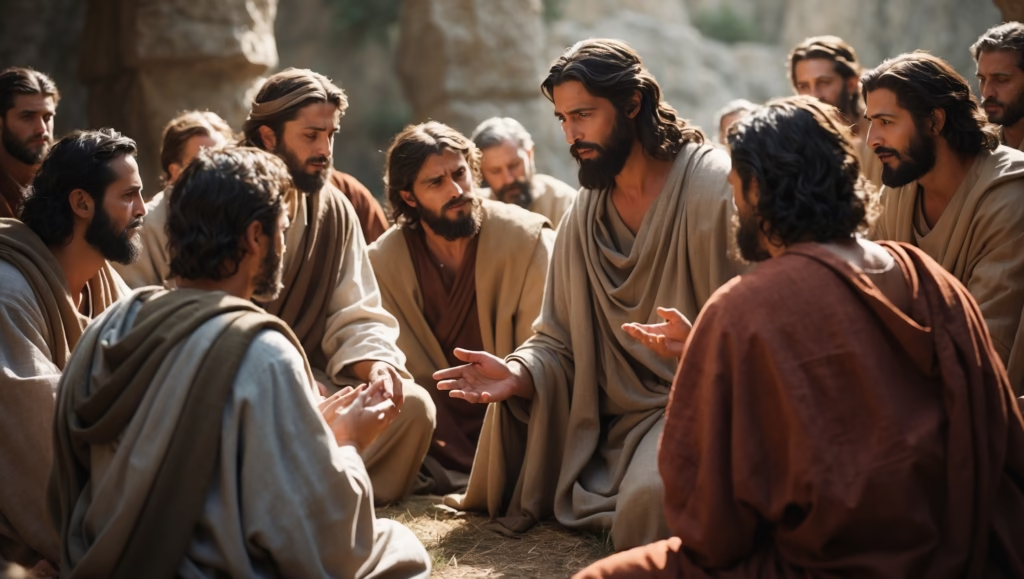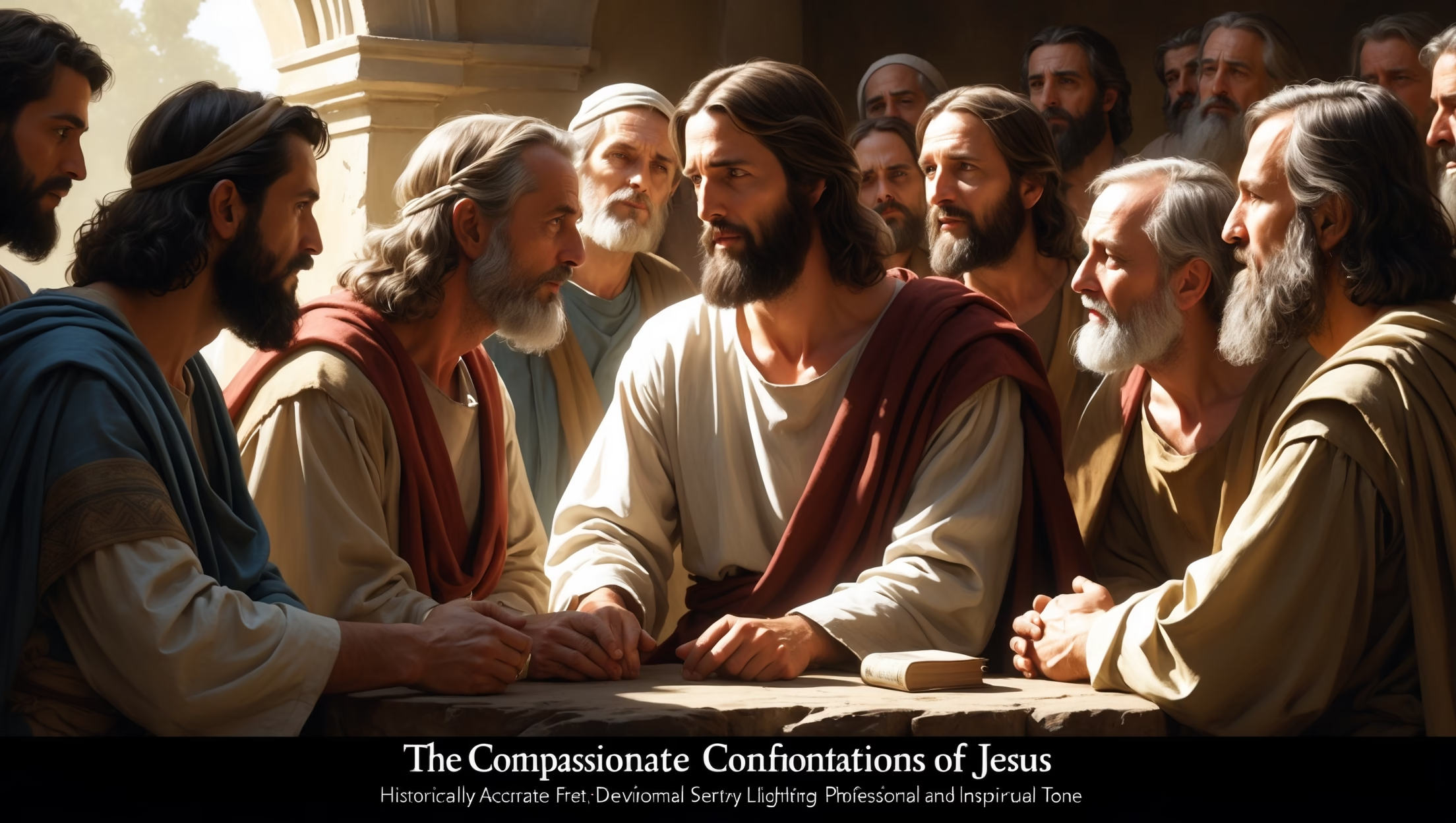Introduction
Throughout the Gospels, Jesus is often depicted confronting individuals and groups, yet His approach was never harsh for its own sake. His confrontations were deeply rooted in compassion, aimed at healing, restoring, and guiding people toward truth. Unlike worldly leaders who may wield confrontation as a tool for power or humiliation, Jesus used confrontation as a means of transformation. His engagements with the Pharisees, the rich young ruler, and even His own disciples reveal a consistent method: speak truth courageously while expressing love. By examining these interactions, we gain insight into how compassion and truth can coexist in difficult conversations.

Jesus and the Pharisees
One of the most frequent targets of Jesus’ confrontations were the Pharisees and other religious leaders. They were often proud of their knowledge, meticulous observance of the law, and social status, yet they frequently neglected justice, mercy, and humility. Jesus did not shy away from calling out their hypocrisy. He declared, “Woe to you, teachers of the law and Pharisees, you hypocrites!” (Matthew 23:13).
Yet, His rebukes were not mere condemnation. Jesus confronted them to expose their spiritual blindness and invite repentance. His criticism aimed to restore a right relationship with God, emphasizing the heart of the law over its external observance. In these interactions, Jesus models a confrontational style that is fearless in addressing wrongdoing but fundamentally motivated by compassion and a desire for restoration. He challenges us to understand that correction without care risks alienation, while confrontation combined with love can lead to transformation.
Jesus and the Rich Young Ruler
Another notable example is Jesus’ encounter with the rich young ruler (Mark 10:17–22). The man approached Jesus with genuine curiosity about eternal life, yet his attachment to wealth hindered his obedience. Jesus confronted this barrier directly, saying, “Go, sell everything you have and give to the poor, and you will have treasure in heaven.” This statement pierced to the heart of the man’s struggle, revealing that his true allegiance was divided.
Importantly, the Gospels emphasize Jesus’ response after the man walked away: “Jesus looked at him and loved him” (Mark 10:21). Even when the confrontation did not yield immediate compliance, His compassion remained evident. This encounter demonstrates that the purpose of confrontation is not coercion but illumination. Jesus’ confrontation was intended to guide the young man toward spiritual freedom, showing that truth delivered in love can awaken self-awareness, even if immediate change does not occur.
Jesus and His Disciples
Jesus’ compassionate confrontations were also evident in His interactions with His disciples. The twelve often misunderstood His mission, argued about greatness, or struggled with fear and doubt. Rather than rebuking them harshly, Jesus used confrontation as a teaching moment.
When the disciples debated who would be greatest in the kingdom of heaven, Jesus responded by placing a child among them and saying, “Whoever wants to be first must be last of all and servant of all” (Mark 9:35). This gentle yet firm correction reshaped their understanding of leadership, humility, and service. Through such confrontations, Jesus cultivated growth, strengthened faith, and clarified His mission. His method illustrates that correction paired with teaching can transform mistakes into opportunities for maturity and leadership.
The Balance of Truth and Love
What sets Jesus’ confrontations apart is His mastery of balancing truth with love. He never compromised the integrity of His message, yet His delivery always considered the person’s capacity to hear and respond. Truth without love can wound, and love without truth can mislead. Jesus exemplified the harmonious integration of both, showing that confrontation can be both courageous and compassionate.
His confrontations aimed at transformation rather than humiliation, reflection rather than resentment, and growth rather than shame. By observing Jesus, we see that confrontation is not inherently negative. When executed with the dual priorities of honesty and empathy, it becomes a powerful tool for healing and moral clarity.
Application for Today
In contemporary life, confronting wrongdoing is often avoided for fear of conflict or rejection. Yet, the model provided by Jesus offers a blueprint for how to engage others effectively. Confrontation should be grounded in care for the person’s well-being, a desire for restoration, and the courage to speak truth boldly.
In workplaces, families, churches, and social relationships, the compassionate confrontation of Jesus serves as a guiding principle. It encourages us to address harmful behaviors while preserving dignity, to speak truth without arrogance, and to challenge others while maintaining relational bonds. This approach not only promotes accountability but fosters trust, mutual respect, and lasting transformation.
Furthermore, Jesus’ model reminds us to evaluate our own motives when confronting others. Are we seeking to dominate, embarrass, or control? Or are we motivated by love, empathy, and the hope of restoration? His example calls us to engage thoughtfully, with patience and humility, ensuring that our confrontations aim to build up rather than tear down.
Conclusion
The compassionate confrontations of Jesus reveal a method of correction that is both fearless and tender. Through His interactions with the Pharisees, the rich young ruler, and His disciples, Jesus demonstrated that confrontation need not be harsh or destructive. Instead, it can be an expression of love, a pathway to truth, and a catalyst for transformation.
By balancing courage with compassion, truth with care, and conviction with gentleness, Jesus offers a timeless model for addressing challenges, guiding others, and fostering spiritual growth. His confrontations remind us that love and truth are inseparable, and that authentic transformation comes when we confront with the intent to restore, teach, and guide. In following His example, we learn that redemptive confrontation is not only possible—it is a reflection of God’s own heart.










